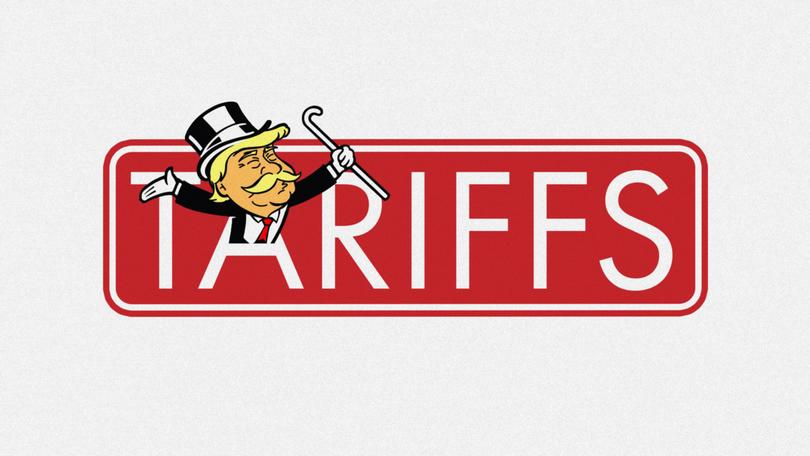Liberation Day: When it comes to tariffs, Donald Trump wants a taste and everyone will be forced to bend knee

Having had a look at the prospect of individually calculating ‘reciprocal’ tariffs on its trading partners, The Don is expected to take the ‘Corleone’ approach of squeezing everyone equally and then expecting them to bend the knee.
The Trump administration loves tariffs. It sees them as a way to pay down its deficit and reinstate America’s position as the manufacturing powerhouse of the world.
Friend or foe, it won’t matter. And much like his previous business transactions, Mr Trump’s art of the deal will commence with an extreme anchor, possibly 20 per cent.
Sign up to The Nightly's newsletters.
Get the first look at the digital newspaper, curated daily stories and breaking headlines delivered to your inbox.
By continuing you agree to our Terms and Privacy Policy.It is up to the rest of the world to form a conga line of supplication and offer up whatever access to the US is worth.
Dr Jenny Gordon, non-resident fellow at the Lowy Institute for International Affairs and former chief economist at the Department of Foreign Affairs and Trade, said the aftermath of ‘Liberation Day’ would look much like what Australia went through in negotiating the free trade agreement that came into force in 2005.
“It does sound like Trump’s going to start with a 20 per cent blanket tariff and then let everybody come on bended knee and ask for concessions. And then we’ll say, this is what we want in exchange … which sounds a lot like free trade agreement negotiation—with a queue out the door.”
Australia has been here before, Dr Gordon said. During the US-Australia FTA, she worked on economic models to identify the value of each tradeoff.
“We were trying to negotiate access to the US market for sugar and beef… and they were trying to get rid of the Pharmaceutical Benefits Scheme and extend copyright protections for another 70 years. Only this time it’s starting with the pre-emptive whack of tariffs.”
An export minnow
According to DFAT, in 2023 Australia’s goods and services exports to the United States were $33.6 billion, with imports from the United States totaling $65b.
The US accounts for less than five per cent of Australia’s exports, but it is the fifth largest market, after China, Japan, South Korea and India.
The Prime Minister highlighted that fact on the eve of Trump’s tariff announcement.
“Australia’s exports to the United States represent about under five per cent of our goods exports. So let’s have some perspective here about standing up for Australia’s national interest,” he said.
Australia’s national interest will be at stake in this fight.
The government does not appear willing to trade domestic policies for $33b in exports.
“We are not willing to trade away the things that make Australia the best country in the world, like our healthcare system. We won’t be weakening our biosecurity laws, and we won’t be trading away our PBS (Pharmaceutical Benefits Scheme,” Foreign Minister Penny Wong told Radio National.
Dr Gordon said that Australia would be better placed to work on diversifying exports instead of trying to cut a deal with Trump.
“I think we should just wear the tariff and look for alternative markets,” she said.
But every other country will be looking for alternative markets as well, setting up a potentially disastrous situation where exporters dump goods that have become too expensive in the US.
The steel industry, which was hit with a 25 per cent tariff on its $1b of exports to the US earlier this month, is lobbying the government to protect it from dumping. Its focused on the damage being caused to the domestic steel fabrication industry due to a surge in imports of very low-priced finished steelwork from Asia.
Aluminium producers, who 150,000 tonnes, or 10 per cent of total output said its main concern was a distortion of international trade flows, and increased risk of trade diversion. The industry employs 21,000 people directly, contributing $18b to Australia’s GDP.
Marghanita Johnson, chief executive of the Australian Aluminium Council applauded Industry minister Ed Husic’s new directive to the Anti-Dumping Commissioner.
“This is the first time a Government has so clearly articulated its expectations of the Commission, recognising the increased risks faced by Australian manufacturing at this time,” she said.
Mr Husic has instructed the Anti-Dumping Commissioner to take a far more assertive stance in defending Australian manufacturers against unfair trade practices.
In a Statement of Expectations issued on April 1, Mr Husic warned of “a significant risk for trade diversion and dumping into the Australian market” amid growing global overcapacity and escalating tariff regimes. He urged the Commissioner to act swiftly, using all available powers to prevent harm to local industry.
“I expect you to prioritise effective remedies for Australian manufacturers and producers being injured by dumping and subsidisation,” Mr Husic said, while also calling for the system to be more accessible for small and medium-sized businesses.
Dr Jenny Gordon said the Government should be proactive in working through existing trade frameworks to minimise the risk of retaliatory dumping and trade distortion.
Rather than resorting to defensive protectionism, she argued the government should coordinate with key trading partners to avoid a spiral of anti-dumping actions.
“We need to see the Australian government getting out there and using these frameworks we’ve already got in place… Let’s avoid a whole bunch of dumping and anti-dumping action between ourselves,” she said, referring to agreements like the twelve member Trans-Pacific Partnership and the Indo-Pacific Regional Comprehensive Economic Partnership.
Australia’s largest exports to the US lie in red meat and pharmaceuticals.
Beef exports to the US are worth about $7b, and have been rapidly growing as the US beef herd is at its lowest level since the 1960s. While one US congressman has suggested America place a 70 per cent tariff on Australia wagyu, that is unlikely to happen.
The America’s National Cattlemen’s Beef Association has called on Mr Trump to negotiate access to the Australian market for American beef, which is currently prohibited on biosecurity grounds. The Australian meat industry has managed to avoid major diseases such as mad cow disease and foot and mouth disease which have devastated herds elsewhere, thanks to strict biosecurity regulations. It would be reluctant to relax those laws for greater market access.
The industry believes it would be able to access other markets, and that a higher likelihood is that American consumers would pay the price of a tariff.
“Australian meat, particularly lean trim, is a significant input into US burger production and is a reliable, safe protein for US consumers,” Australian Meat Industry Council CEO, Tim Ryan said.
“With strong demand in the US and globally for Australian meat, the American people will be the ones to wear the cost of any tariffs applied to our exports.”
Pharmaceuticals are the second highest export to the USA, with star biotech CSL a key exporter, sending vaccines, plasma and iron infusions into the US from both its Australian factory and from overseas locations.
CSL and other biotechs facing tariffs will be under pressure to move manufacturing to the US, but that poses incredible logistical challenges.
Pharmaceutical production is highly regulated, requiring precision instruments, and building any factory in the US would take years.
That means US consumers will end up paying more for medicines, given the challenges of bringing more supply onstream.
One biotech investor who asked not to be named said the imposition of tariffs would be a “shit-show” for many companies operating in Australia, as the majority of the intellectual property developed here is manufactured else where before being exported to the United States.

